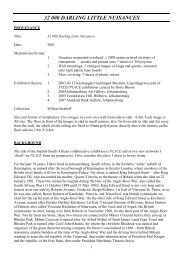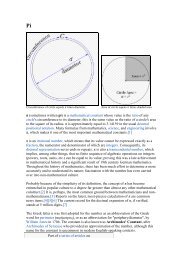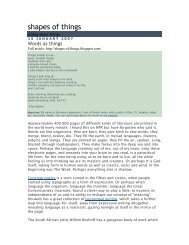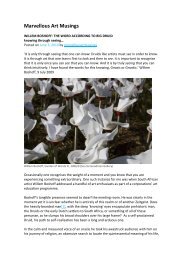Miranthe Staden Garbett Report - Willem Boshoff
Miranthe Staden Garbett Report - Willem Boshoff
Miranthe Staden Garbett Report - Willem Boshoff
Create successful ePaper yourself
Turn your PDF publications into a flip-book with our unique Google optimized e-Paper software.
spiritual features of places as a way of looking for the deeper truth of<br />
things…these translators express themselves, their society, and the universal<br />
through their own subjectivity.<br />
Thus accourding to Loukaki (1997: 309) “a genius loci speaks in terms of essential and<br />
authentic character of places as well as contextual, cultural issues, about who has the<br />
power and privilege to define standards of judgement for the understanding and<br />
transformation of a particular place”. Thus this site could be said to have been rendered<br />
sacred through the artist’s knowledge and manipulation of site, material and concept.<br />
Culturally the site is significant on many levels, as a world heritage site, it’s a global<br />
symbol, a golden thread linking us to our past and to each other. Yet this particular<br />
location as well as the exact cause of the evolutionary leap, is still hotly debated. The<br />
out of Africa hypothesis is relatively recent, as are the asteroid theories and Gould’s<br />
theory of punctuated evolution. These theories are firmly rooted within a contemporary<br />
scientific and cultural context and thus require a brief overview. According to Hilton<br />
Barber and Berger (2004:10), the Cradle of Humankind is “a unique location blessed<br />
with a greater wealth of prehistory of humankind than almost any other place on<br />
Earth.” Within the scientific, modern and global socio-political paradigm, this area<br />
acquires a new meaning, what Korp calls ‘domain’. According to Stringer (1996:7) “we<br />
see evidence of this startling 100 000 year old genesis not only in the bones of the dead<br />
but in the genes of people alive today, and even in the words we speak. This idea also<br />
shows the remarkable similarities of every member of the human population of this<br />
planet.” Mogale City, as it is now called, has been awarded the highest conservation<br />
status, thus also giving credence to the notion of an African Renaissance. All these<br />
possible meanings are now embedded in the domain of this site.<br />
The out of Africa hypothesis for human origins began to emerge in the early 20 th century<br />
as a result of the fossil findings of David Draper, Robert Broom, and Louis and Mary








